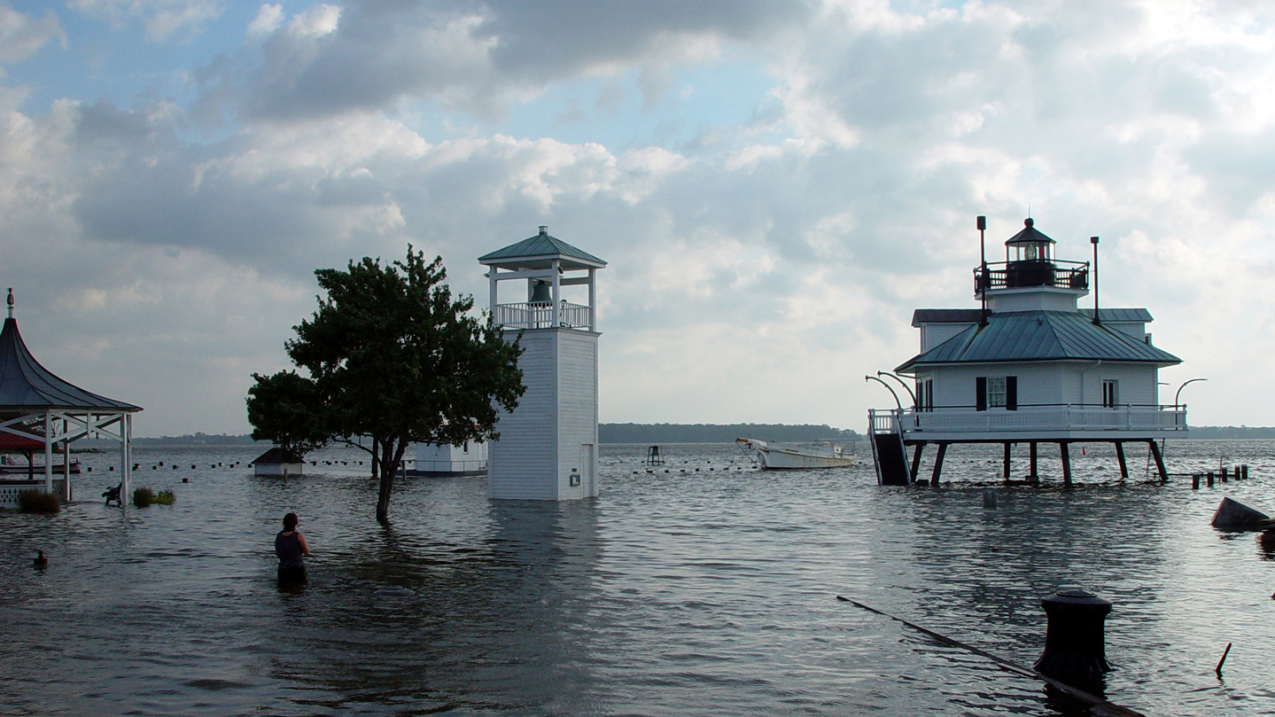
Flooding at the Hooper Strait Lighthouse in St. Michaels, Maryland, due to heavy rain and storm surge after the eye of Hurricane Isabel passed south of Chesapeake Bay on Sept. 11, 2003. (Image credit: Chesapeake Bay Maritime Museum)
NOAA Sea Grant: 50 years of science serving America’s coasts
What is NOAA Sea Grant?
Strengthening coastal communities
Preparing marine workforces
Protecting Great Lakes communities
Building partnerships
For 50 years, NOAA’s National Sea Grant College Program has brought together scientists, engineers, extension agents, educators and students across the nation. It connects science to people, and strengthens the resilience of coastal communities in a changing world.
Sea Grant began in 1966, modeled after the highly successful Land Grant College program founded in the 19th century. Land Grant brought the federal government and state universities together to share science to improve America’s farms, food industry and land use. Sea Grant shares science to improve how we use our ocean and Great Lakes resources.
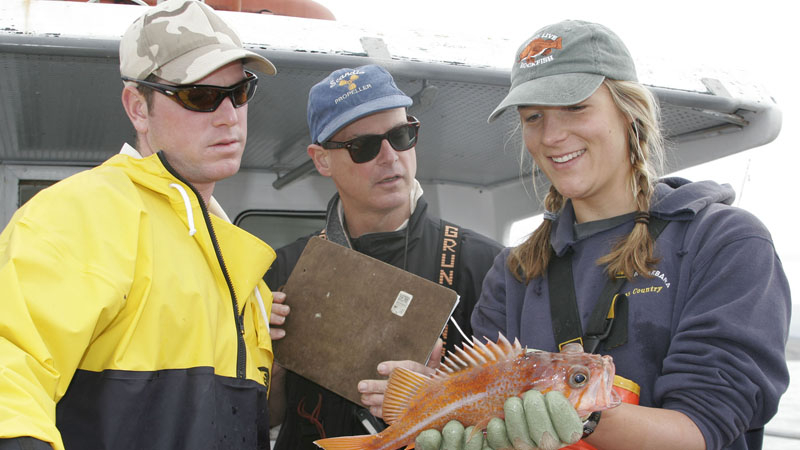
The Sea Grant network includes 33 programs based at universities in every coastal and Great Lakes state, Puerto Rico and Guam. Through its John A. Knauss Marine Policy Fellowship, Sea Grant trains graduate students who will be tomorrow’s leading environmental scientists and policy makers.
Sea Grant programs work to boost local economies and strengthen the resilience of our coastal communities. Last year, the economic impact of Sea Grant’s work around the United States reached $320 million, a 475 percent return on the federal investment of $67.3 million.
Despite warnings of storm surge, many of the 117 deaths during Hurricane Sandy in 2012 were drownings. This loss of life and devastation to Northeast coastal communities prompted actions to figure out how to help coastal communities better prepare for the next big storm.
“The storm predictions were quite good. But we need to understand why we still had such a great loss of life, and how we can prevent it in the future,” said Connecticut Sea Grant's Nancy Balcom.
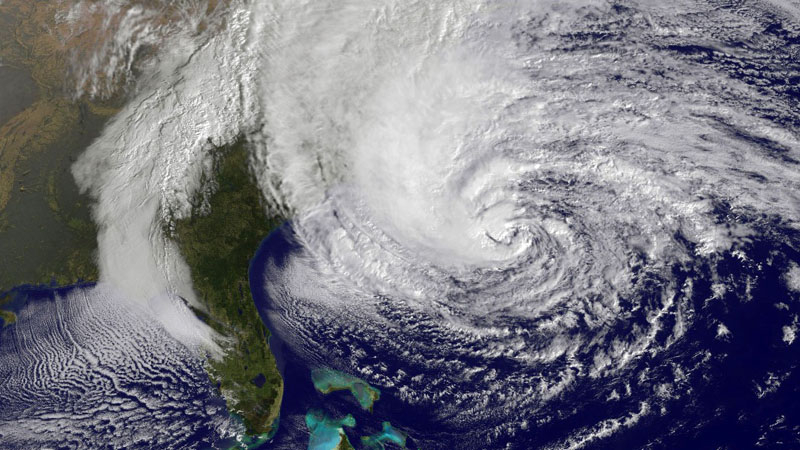
After the storm, Sea Grant funded 10 research projects offsite link to look at how coastal residents in Connecticut, New Jersey and New York got their storm warnings, and what they did afterwards.
Researchers found that people evacuated in the face of strong storms depending on the storms they’ve personally seen. Also, coastal residents are much more likely to evacuate if local authorities are giving the orders, and if they are mandatory.
Balcom and other Sea Grant extension agents are now working with local and national officials, using this research to improve storm warnings and preparedness. Sea Grant is also helping other coastal communities improve their resilience to natural disasters in many states including Hawaii, Louisiana and Oregon.
Courtney Carothers, an associate professor at the University of Alaska Fairbanks and Alaska Sea Grant scientist, has spent her career studying the effects of fishery management on Alaska’s coastal villages.
She has seen Alaska’s fishing communities grow older and smaller in recent decades. She and her colleagues are studying why fewer young people are choosing commercial fishing as a living.
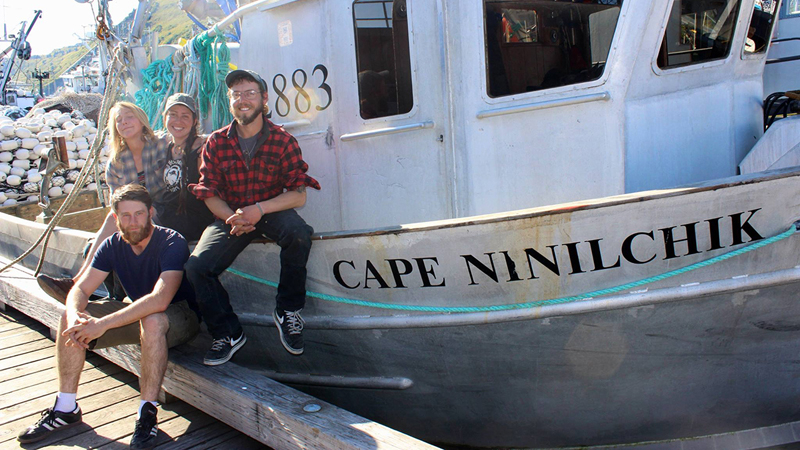
Fishing has long been a way of life in Alaska, and the lack of young people coming into the industry is a major concern. Today, the average Alaska fishery permit owner is 50 years old. In 1980, that age was 40. Even though Alaska produces 60 percent of the nation’s seafood, many young people see little opportunity in the industry. They don’t believe they can work their way to be boat owners with on-going fishing businesses.
The Sea Grant researchers offsite link are looking at how fishing permits and catch-share privileges, an amount of fish that can be legally caught, are passed from one generation to the next. One goal is to address the barriers faced by young people who want to enter and grow in the fishing industry.
Other Sea Grant projects designed to support Alaska’s marine jobs and industries include annual training for fishermen in marine safety offsite link, training in safe handling offsite link of seafood, a tool to help fishermen audit their own energy use offsite link and identify energy and cost savings, a guide to help schools purchase local seafood offsite link, and a youth fishermen’s summit offsite link to encourage and support young people working in the field.
In August 2014, dangerously high levels of toxins from an algal bloom in Lake Erie left 400,000 people in Toledo, Ohio, without safe drinking water for more than two days. Sea Grant responded immediately with water quality testing kits and expert advice on how to resolve the disaster.
We’re glad we were able to reach people quickly.
— Jeff Reutter, recently retired Ohio Sea Grant director.
Algal blooms reduce tourism income and overall quality of life near the shore, and the toxin can cause skin rashes, gastrointestinal symptoms, and liver and nervous system damage. The primary cause of blooms in Lake Erie is phosphorous runoff from agricultural fertilizer applied to cropland, wastewater discharge and stormwater runoff.
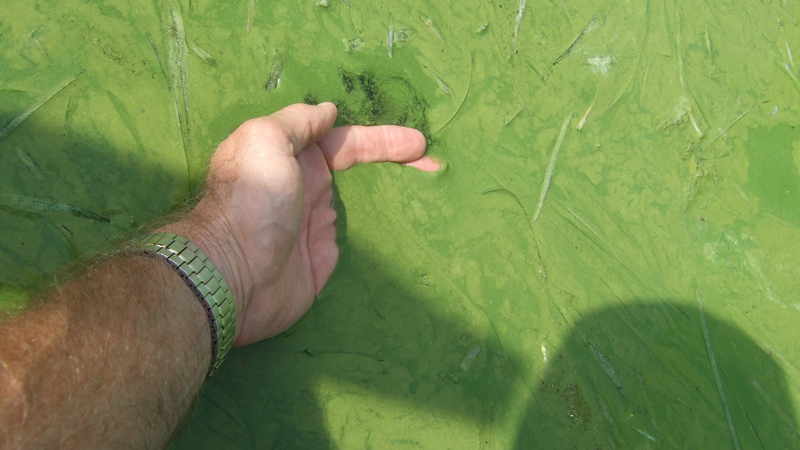
Since the early 1970s, Ohio Sea Grant has studied how harmful algal blooms develop and what steps can be taken to prevent their formation and lessen their effects on Lake Erie communities. In 2016, Ohio Sea Grant announced new research projects, including many that focus on harmful algal blooms offsite link. Sea Grant extension specialists get these findings to water treatment plant managers, farmers, charter boat captains, elected officials and other decision makers, so that they can better address all aspects of the HABs problem.
Harmful algal bloom research is also taking place in other states, including Washington offsite link, California offsite link and New York offsite link.
While our nation’s coasts face increasing climate-related threats and hazards, many of these problems are specific and unique to local communities.
A key part of Sea Grant’s strategy is to build strong partnerships with coastal communities to share funding and scientific expertise and to solve problems.
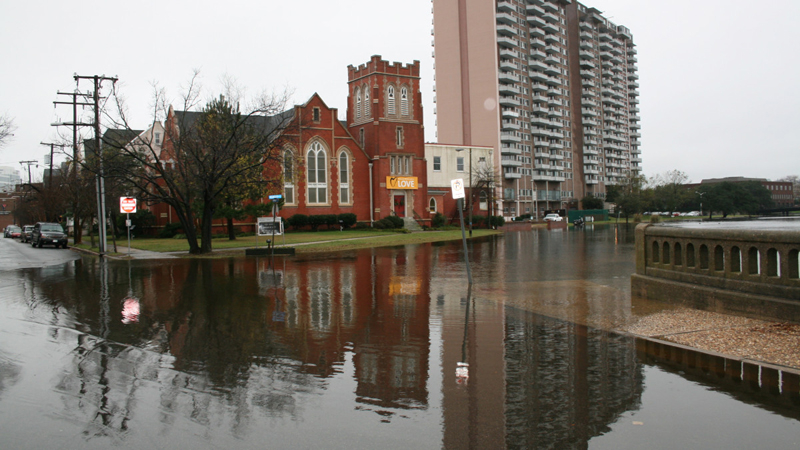
In 2014, Virginia Sea Grant awarded $50,000 to Wetlands Watch, a Virginia nonprofit organization, to develop a plan to make Chesterfield Heights, a low-to-moderate income, historically African-American neighborhood in Norfolk, Virginia, more resilient in the face of increased flooding and projected sea level rise. The grant funded architectural and engineering designs by students from Hampton University and Old Dominion University.
Local design and building professionals advised the students. They used science-based solutions such as living seashores and improved culverts in their solutions. The students presented the designs to Norfolk city officials, who included them in a larger proposal for federal funding to improve community resiliency. In late 2015, the region received $120 million in federal funding for implementing this resiliency project — a remarkable return on the initial Sea Grant investment.
Just as coastal populations are projected to increase, so will the challenges for coastal communities from sea level rise, severe storms and warming coastal waters. More people will be vulnerable to the effects of climate change.
As NOAA Sea Grant celebrates its half century, it remains committed and well-positioned to address the emerging challenges around our nation’s coasts. Sea Grant’s time-tested strategy is to listen to local needs, provide novel and science-based approaches and work with communities to build strong partnerships to implement solutions.
Learn more about NOAA Sea Grant’s 50th anniversary, including upcoming celebration events, stories and videos on innovative science and service around the nation’s coasts.
For 50 years, NOAA’s National Sea Grant College Program has brought together scientists, engineers, extension agents, educators and students across the nation. It connects science to people, and strengthens the resilience of coastal communities in a changing world.
Sea Grant began in 1966, modeled after the highly successful Land Grant College program founded in the 19th century. Land Grant brought the federal government and state universities together to share science to improve America’s farms, food industry and land use. Sea Grant shares science to improve how we use our ocean and Great Lakes resources.

The Sea Grant network includes 33 programs based at universities in every coastal and Great Lakes state, Puerto Rico and Guam. Through its John A. Knauss Marine Policy Fellowship, Sea Grant trains graduate students who will be tomorrow’s leading environmental scientists and policy makers.
Sea Grant programs work to boost local economies and strengthen the resilience of our coastal communities. Last year, the economic impact of Sea Grant’s work around the United States reached $320 million, a 475 percent return on the federal investment of $67.3 million.
Despite warnings of storm surge, many of the 117 deaths during Hurricane Sandy in 2012 were drownings. This loss of life and devastation to Northeast coastal communities prompted actions to figure out how to help coastal communities better prepare for the next big storm.
“The storm predictions were quite good. But we need to understand why we still had such a great loss of life, and how we can prevent it in the future,” said Connecticut Sea Grant's Nancy Balcom.

After the storm, Sea Grant funded 10 research projects offsite link to look at how coastal residents in Connecticut, New Jersey and New York got their storm warnings, and what they did afterwards.
Researchers found that people evacuated in the face of strong storms depending on the storms they’ve personally seen. Also, coastal residents are much more likely to evacuate if local authorities are giving the orders, and if they are mandatory.
Balcom and other Sea Grant extension agents are now working with local and national officials, using this research to improve storm warnings and preparedness. Sea Grant is also helping other coastal communities improve their resilience to natural disasters in many states including Hawaii, Louisiana and Oregon.
Courtney Carothers, an associate professor at the University of Alaska Fairbanks and Alaska Sea Grant scientist, has spent her career studying the effects of fishery management on Alaska’s coastal villages.
She has seen Alaska’s fishing communities grow older and smaller in recent decades. She and her colleagues are studying why fewer young people are choosing commercial fishing as a living.

Fishing has long been a way of life in Alaska, and the lack of young people coming into the industry is a major concern. Today, the average Alaska fishery permit owner is 50 years old. In 1980, that age was 40. Even though Alaska produces 60 percent of the nation’s seafood, many young people see little opportunity in the industry. They don’t believe they can work their way to be boat owners with on-going fishing businesses.
The Sea Grant researchers offsite link are looking at how fishing permits and catch-share privileges, an amount of fish that can be legally caught, are passed from one generation to the next. One goal is to address the barriers faced by young people who want to enter and grow in the fishing industry.
Other Sea Grant projects designed to support Alaska’s marine jobs and industries include annual training for fishermen in marine safety offsite link, training in safe handling offsite link of seafood, a tool to help fishermen audit their own energy use offsite link and identify energy and cost savings, a guide to help schools purchase local seafood offsite link, and a youth fishermen’s summit offsite link to encourage and support young people working in the field.
In August 2014, dangerously high levels of toxins from an algal bloom in Lake Erie left 400,000 people in Toledo, Ohio, without safe drinking water for more than two days. Sea Grant responded immediately with water quality testing kits and expert advice on how to resolve the disaster.
We’re glad we were able to reach people quickly.
— Jeff Reutter, recently retired Ohio Sea Grant director.
Algal blooms reduce tourism income and overall quality of life near the shore, and the toxin can cause skin rashes, gastrointestinal symptoms, and liver and nervous system damage. The primary cause of blooms in Lake Erie is phosphorous runoff from agricultural fertilizer applied to cropland, wastewater discharge and stormwater runoff.

Since the early 1970s, Ohio Sea Grant has studied how harmful algal blooms develop and what steps can be taken to prevent their formation and lessen their effects on Lake Erie communities. In 2016, Ohio Sea Grant announced new research projects, including many that focus on harmful algal blooms offsite link. Sea Grant extension specialists get these findings to water treatment plant managers, farmers, charter boat captains, elected officials and other decision makers, so that they can better address all aspects of the HABs problem.
Harmful algal bloom research is also taking place in other states, including Washington offsite link, California offsite link and New York offsite link.
While our nation’s coasts face increasing climate-related threats and hazards, many of these problems are specific and unique to local communities.
A key part of Sea Grant’s strategy is to build strong partnerships with coastal communities to share funding and scientific expertise and to solve problems.

In 2014, Virginia Sea Grant awarded $50,000 to Wetlands Watch, a Virginia nonprofit organization, to develop a plan to make Chesterfield Heights, a low-to-moderate income, historically African-American neighborhood in Norfolk, Virginia, more resilient in the face of increased flooding and projected sea level rise. The grant funded architectural and engineering designs by students from Hampton University and Old Dominion University.
Local design and building professionals advised the students. They used science-based solutions such as living seashores and improved culverts in their solutions. The students presented the designs to Norfolk city officials, who included them in a larger proposal for federal funding to improve community resiliency. In late 2015, the region received $120 million in federal funding for implementing this resiliency project — a remarkable return on the initial Sea Grant investment.
Just as coastal populations are projected to increase, so will the challenges for coastal communities from sea level rise, severe storms and warming coastal waters. More people will be vulnerable to the effects of climate change.
As NOAA Sea Grant celebrates its half century, it remains committed and well-positioned to address the emerging challenges around our nation’s coasts. Sea Grant’s time-tested strategy is to listen to local needs, provide novel and science-based approaches and work with communities to build strong partnerships to implement solutions.
Learn more about NOAA Sea Grant’s 50th anniversary, including upcoming celebration events, stories and videos on innovative science and service around the nation’s coasts.

